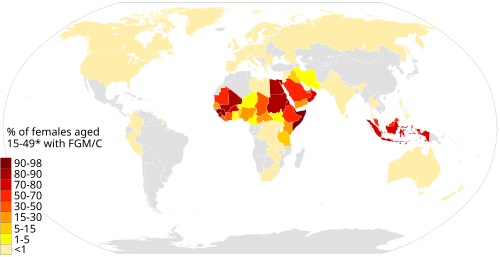
Back معدلات انتشار ختان الإناث حسب الدولة Arabic پراکندگی جغرافیایی سنت بریدن آلت تناسلی زنان Persian Mutilazioni genitali femminili nel mondo Italian

Female genital mutilation (FGM), also known as female genital cutting (FGC), female genital mutilation/cutting (FGM/C) and female circumcision,[2] is practiced in 30 countries in western, eastern, and north-eastern Africa,[3] in parts of the Middle East[4][5] and Asia,[6][7] and within some immigrant communities in Europe, North America and Australia.[3][8][9] The WHO defines the practice as "all procedures that involve partial or total removal of the external female genitalia, or other injury to the female genital organs for non-medical reasons."[10]
In a 2013 UNICEF report covering 29 countries in Africa and the Middle East, Egypt had the region's highest total number of women that have undergone FGM (27.2 million), while Somalia had the highest percentage (prevalence) of FGM (98%).[11]
The world's first known campaign against FGM took place in Egypt in the 1920s.[11] FGM prevalence in Egypt in 1995 was still at least as high as Somalia's 2013 world record (98%), despite dropping significantly since then among young women.[12] Estimates of the prevalence of FGM vary according to source.
- ^ "Female genital mutilation/cutting: a call for a global response" (PDF). End FGM European Network, U.S. End FGM/C Network and Equality Now. March 2020. Retrieved 6 May 2020.
- ^ Nussbaum, Martha (1999). Sex and Social Justice. p. 119.
Although discussions sometimes use the terms 'female circumcision' and 'clitoridectomy', 'female genital mutilation' (FGM) is the standard generic term for all these procedures in the medical literature ... The term 'female circumcision' has been rejected by international medical practitioners because it suggests the fallacious analogy to male circumcision ...
- ^ a b Cite error: The named reference
vb2005was invoked but never defined (see the help page). - ^ FGM – Where is it practiced? Archived 2013-10-02 at the Wayback Machine European Campaign on FGM & Amnesty International (2012)
- ^ Barbarani, Sofia (March 4, 2013) Tackling Female Genital Mutilation in the Kurdistan Region. The Kurdistan Tribune
- ^ World Health Organization, Female genital mutilation: an overview. 1998, Geneva: World Health Organization
- ^ Clarence-Smith, William G. (2012) "Female Circumcision in Southeast Asia since the Coming of Islam", in Chitra Raghavan and James P. Levine (eds.), Self-Determination and Women’s Rights in Muslim Societies, Brandeis University Press. pp. 124–146. ISBN 978-1611682809
- ^ "Australia's Highest Court Rules Female Genital Mutilation Illegal in All Forms". Global Citizen. 17 October 2019. Retrieved 20 October 2019.
- ^ Abdulcadir J (2011). "Care of women with female genital mutilation/cutting". Swiss Medical Weekly. 140: w13137. doi:10.4414/smw.2011.13137. PMID 21213149.
- ^ "Female genital mutilation", World Health Organization, February 2010.
- ^ a b Cite error: The named reference
FGM2013was invoked but never defined (see the help page). - ^ The taboo has been broken: Fighting Female Genital Mutilation in Egypt Archived 2018-08-09 at the Wayback Machine. According to this UNDP report, FGM prevalence among 15 to 30-year-olds dropped to 72% already in 2008 after having been 96% in 1995, which means that the prevalence among all women in 1995 was even higher than 76%.